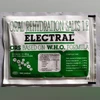)
Photo (Wikimedia Commons)
In many parts of the world, a simple mixture of water, salt, and sugar administered orally is saving countless lives. This solution, known as Oral Rehydration Solution (ORS), plays a crucial role in combating dehydration caused by diarrhoea, particularly in young children. Each year on July 29th, World ORS Day is celebrated to emphasise the essential role ORS plays in combating dehydration caused by diarrhoea, the second leading cause of death among children under the age of five.
ORS is not just a hero for children; it is a universal remedy that protects people of all ages from dehydration and diarrhoea. The World Health Organization (WHO) recommends an ORS solution with a total osmolarity of 245 mmol per litre to effectively manage dehydration from diarrhoea and other causes.
Life-saving impact of oral rehydration therapy
Over the past decades, the number of children dying from diarrhoeal diseases has significantly decreased, dropping by two-thirds since 1990, according to a report by online publication Our World in Data. Oral rehydration therapy (ORT) has played a crucial role in this success, saving an estimated 70 million lives since its introduction in the late 1970s. Despite its effectiveness, nearly half a million children still die annually from diarrhoeal diseases. Expanding the global reach of ORT could save countless more lives.
In 1990, 2.6 million people died from diarrhoeal diseases. Today, this number has been reduced by about one million, thanks to significant advancements in combating these diseases, the report mentioned. The reduction in child mortality rates has been even more dramatic, with deaths among children under five falling by two-thirds since 1990.
Diarrhoea can lead to life-threatening dehydration, necessitating treatments that address fluid loss. Oral rehydration therapy is the common treatment to prevent dehydration caused by diarrhoea. The medical journal The Lancet has hailed ORT as “the most important medical advance of the 20th century.”
How does ORS work?
While drinking water can replace some lost fluids during diarrhoea, it cannot fully compensate for severe cases. ORT is effective due to the molecular mechanisms governing sugar and sodium absorption in the gut. Gut lining cells have receptors that actively absorb sugar molecules, a process dependent on sodium ions. This absorption increases water and chloride ion uptake, offsetting the loss of essential ions and fluids in diarrhoea patients. The recommended ORT formulation has evolved to include other fluids and zinc, enhancing recovery and reducing recurrence.
What are the advantages of ORS?
ORS is a cost-effective solution that is affordable and easy to produce and distribute, making it accessible, especially in low-resource areas. Its ease of use is another significant advantage; ORS can be administered at home without specialised medical knowledge, which is crucial in regions where immediate medical care is not readily available.
Moreover, the timely and appropriate use of ORS can significantly reduce the severity of dehydration, leading to lower hospitalisation rates and preventing fatalities, particularly among infants and young children. Additionally, ORS is safe for all age groups, including infants, making it a versatile solution for managing dehydration and diarrhoea in diverse populations.
Difference between ORT and IVT
Despite being low-tech, ORT is highly effective. Studies show no significant difference in effectiveness between ORT and intravenous rehydration therapy (IVT). Given IVT’s invasive nature and requirement for trained staff, ORT is recommended as the first-line treatment, with IVT reserved for cases where ORT is ineffective.
ORT is also much more cost-effective than IVT. According to UNICEF, providing a course of ORT in low-income countries costs around $0.50. While the saline solution for IVT is only slightly more expensive, the additional costs for medical staff, equipment, hospital stays, and longer treatment courses make IVT significantly more expensive.
First Published: Jul 29 2024 | 2:02 PM IST









